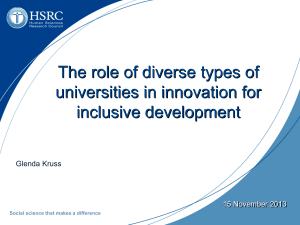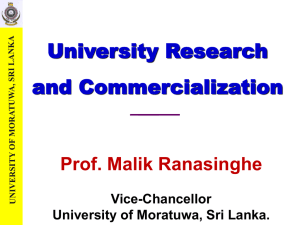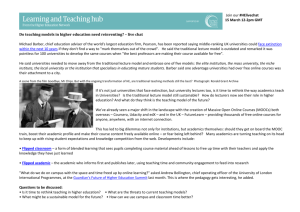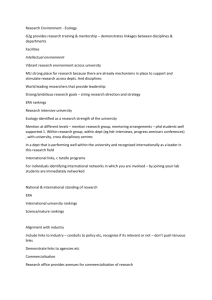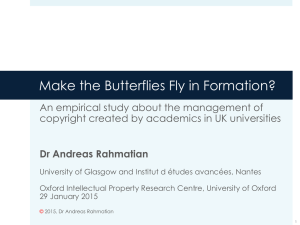Science and Public Policy Volume 38, Issue 6, Jul. 2011 1. Title
advertisement
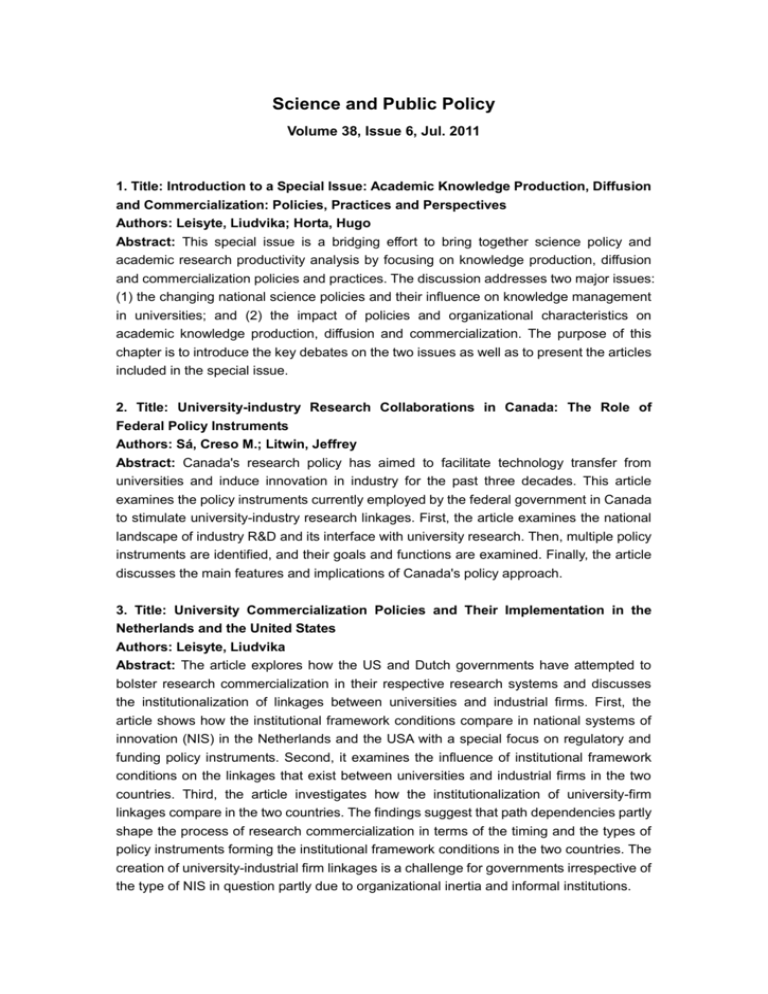
Science and Public Policy Volume 38, Issue 6, Jul. 2011 1. Title: Introduction to a Special Issue: Academic Knowledge Production, Diffusion and Commercialization: Policies, Practices and Perspectives Authors: Leisyte, Liudvika; Horta, Hugo Abstract: This special issue is a bridging effort to bring together science policy and academic research productivity analysis by focusing on knowledge production, diffusion and commercialization policies and practices. The discussion addresses two major issues: (1) the changing national science policies and their influence on knowledge management in universities; and (2) the impact of policies and organizational characteristics on academic knowledge production, diffusion and commercialization. The purpose of this chapter is to introduce the key debates on the two issues as well as to present the articles included in the special issue. 2. Title: University-industry Research Collaborations in Canada: The Role of Federal Policy Instruments Authors: Sá, Creso M.; Litwin, Jeffrey Abstract: Canada's research policy has aimed to facilitate technology transfer from universities and induce innovation in industry for the past three decades. This article examines the policy instruments currently employed by the federal government in Canada to stimulate university-industry research linkages. First, the article examines the national landscape of industry R&D and its interface with university research. Then, multiple policy instruments are identified, and their goals and functions are examined. Finally, the article discusses the main features and implications of Canada's policy approach. 3. Title: University Commercialization Policies and Their Implementation in the Netherlands and the United States Authors: Leisyte, Liudvika Abstract: The article explores how the US and Dutch governments have attempted to bolster research commercialization in their respective research systems and discusses the institutionalization of linkages between universities and industrial firms. First, the article shows how the institutional framework conditions compare in national systems of innovation (NIS) in the Netherlands and the USA with a special focus on regulatory and funding policy instruments. Second, it examines the influence of institutional framework conditions on the linkages that exist between universities and industrial firms in the two countries. Third, the article investigates how the institutionalization of university-firm linkages compare in the two countries. The findings suggest that path dependencies partly shape the process of research commercialization in terms of the timing and the types of policy instruments forming the institutional framework conditions in the two countries. The creation of university-industrial firm linkages is a challenge for governments irrespective of the type of NIS in question partly due to organizational inertia and informal institutions. 4. Title: How does Size Matter For Science? Exploring the Effects of Research Unit Size on Academics' Scientific Productivity and Information Exchange Behaviors Authors: Horta, Hugo; Lacy, T Austin Abstract: This article analyzes the impact of research unit size on academics' scientific output and communication behavior with peers, controlling for individual and organizational characteristics, including the academics' engagement in teaching. Results show that research unit size does not influence total scientific output, but rather the scientific output profile of individual academics. Upon disaggregating the output we find that academics at larger research units publish more in international than in national peer-reviewed journals. This suggests that research unit size positively affects international visibility, a venue that may proxy for research quality. The analysis also shows that as research unit size increases, it influences academics' overall communication. Most importantly, the academics' information exchange with peers at both national and international levels is highest at larger research units, suggesting that research unit size facilitates contact with academics at both national and international institutions. 5. Title: Organizational and Individual Determinants of Patent Production of Academic Scientists and Engineers in the United States Authors: Huang, Wan-Ling; Feeney, Mary K.; Welch, Eric W. Abstract: This article contributes to an important literature on the determinants of academic patenting. We develop and test a model that predicts how individual characteristics and organizational factors affect individual patenting production. The analysis uses zero-inflated negative binomial regression on data from a 2010 national survey of 1,379 US-based university scientists and engineers, 624 of which hold no patents assigned to their current university. Findings from this research generally support our hypotheses that individual and organizational factors are associated with individual patent production. We find that while university patent policy and university technology transfer offices may be important for encouraging or discouraging scientists to patent the first time, department incentives and individual preferences and characteristics predict the number of patents that faculty produce. This research supports prior literature and develops new perspectives on how universities and policy-makers can understand and shape how individual and organizational constraints and incentives affect patent productivity. 6. Title: Mind the Gap and Bridge the Gap: Research Excellence and Diffusion of Academic Knowledge in Sweden Authors: Wigren-Kristoferson, Caroline; Gabrielsson, Jonas; Kitagawa, Fumi Abstract: This paper aims to highlight the changing and diversifying nature of academic work related to various forms of knowledge production and diffusion. Focusing on the changing research policy landscape in Sweden, three interrelated questions are investigated: what academics do in terms of commercialisation and public dissemination; how they perform these activities; and why they engage in these activities. Based on data from a recent survey with over 10,000 academics in Sweden, we identify and analyse 'high-performing' researchers, in the context of the commercialisation and public dissemination of their academic work. The quantitative analysis is supplemented by qualitative interviews with scientists at strong research environments in Sweden. We argue that there is a virtuous cycle connecting different academic activities in strong research environments — research excellence and excellence in knowledge production on one hand, and knowledge diffusion activities, such as commercialisation and public dissemination, on the other hand. 7. Title: The Co-evolution of Universities' Academic Research and Knowledge-Transfer Activities: The Case of South Korea Authors: Kwon, Ki-Seok Abstract: We focus on the relationship between universities' academic research and knowledge transfer and the relationship between the national innovation system and the higher education system during a country's transition from catch-up to developed country. We find a structural similarity between publishing and patenting activities and industrial structure by discipline and sector. The two activities have co-evolved with structural changes in industry throughout different periods. Publications have shifted from being close to the traditional industries to the high-tech industries. Academic patents show a similar change. The recent increase in co-publishing and co-patenting between universities, industry and public research institutes implies a vitalisation of the interactions between these three. Our results explain the South Korean Government's efforts to support both academia and industry in a harmonised way, reflecting the different developmental stages of the Korean innovation system. These findings provide the basis for policy recommendations for supporting universities in South Korea as well as in other Asian countries that are achieving rapid economic catch-up. 8. Title: Business Models and Value Creation Within the Biopharmaceutical Industry Authors: Terje Grønning Abstract: The article reviews the book “Innovation and Commercialisation in the Biopharmaceutical Industry: Creating and Capturing Value” by Bruce Rasmussen.

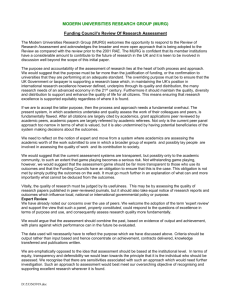
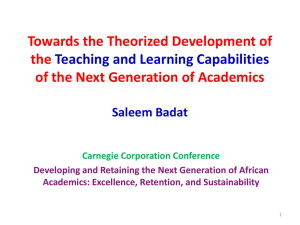
![Introduction [max 1 pg]](http://s3.studylib.net/store/data/007168054_1-d63441680c3a2b0b41ae7f89ed2aefb8-300x300.png)
